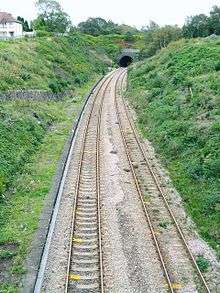Cockett railway station

Cockett station was a former station on the West Wales Line from Swansea to Gowerton and onwards to Llanelli.
The station was located on the west side of Swansea in the residential area of Cockett.
History
The railway line between Landore and Carmarthen was opened on 11 October 1852 by the broad gauge South Wales Railway, which later became part of the Great Western Railway. The engineer of this line was Brunel. Originally, the first station westwards from Landore was at Loughor; Cockett and Gowerton stations were opened at later dates. Cockett station was closed to passenger traffic on and from 2 November 1964.
Cockett Tunnel
Just east of the station, towards Swansea, was the 829 yard Cockett Tunnel. The tunnel was cut through unstable soft ground and had wide cuttings at a shallow angle at either end.
The tunnel suffered a partial collapse in 1899, which was held to have been caused by the resumption of pumping operations at the long-closed Weig-fawr colliery,[1] owned by Philip Richard (II), the flooded workings of which extended beneath the tunnel. The tunnel was completely closed for four weeks, after which traffic was resumed on a single line, but it was not fully restored until 1903,[2] by which time steel ribs had been inserted into the bore of the tunnel at its eastern end (not the location of the collapse) to strengthen the roof. These were found to unduly restrict the loading gauge within the tunnel and were subsequently removed[3] (by 1916).[4] The eastern end of the tunnel was opened out (reducing the length to 788 yards) and the cutting sides were supported by two brick-built flying arches (51°38′01″N 3°58′02″W / 51.6336°N 3.9671°W).[5][6] The banks of the cutting were so unstable that even during this opening-out work, timber horseshoe shoring was required.
References
- ↑ Board of Trade report, available online http://www.railwaysarchive.co.uk/eventsummary.php?eventID=6127
- ↑ R.A. Cooke, Track Layout Diagrams of the Great Western Railway and British Railways Western Region
- ↑ "Track Topics" by W.G. Chapman, published in the 1920s by the Great Western Railway Company
- ↑ Ordnance Survey 1:2500 plan
- ↑ Jones, Stephen K. (2006). Brunel in South Wales. II: Communications and Coal. Tempus. pp. 153–154. ISBN 0-7524-3918-9.
- ↑ "Cockett Bridge and tunnel near m.p. 216 and a quarter". RCTS.
External links
Coordinates: 51°38′15″N 3°58′42″W / 51.6376°N 3.9782°W